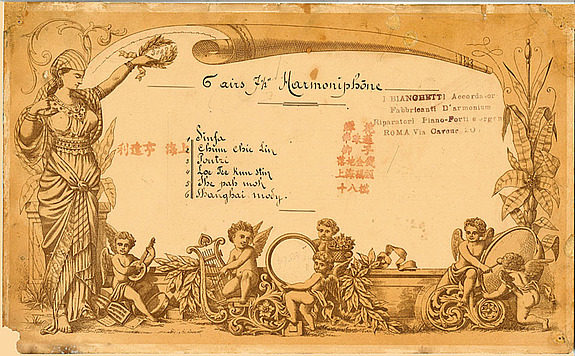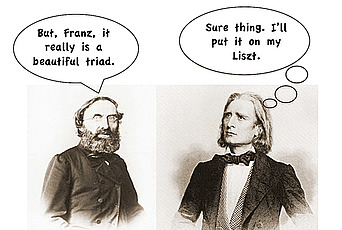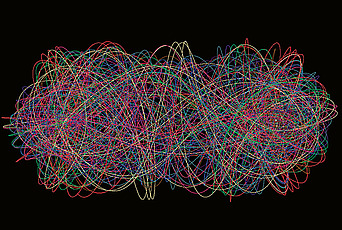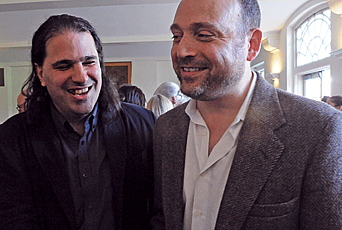The Sound of Scholarly Serendipity

When I arrived at the Institute last September, I thought I knew exactly what I would accomplish as a Member in the School of Historical Studies—I would complete my book, Extreme Exoticism: Japan in the American Musical Imagination, and would launch a new project on vocal timbre in twentieth-century music. By January, having made reasonable progress, these goals still appeared attainable. However, through a chance encounter with a nineteenth-century musical artifact, my carefully crafted research schedule was completely derailed. This opportune encounter led me to make a series of discoveries concerning two of Puccini’s operas and to develop insights into the global circulation of music over the past two centuries.
My wife and I had promised our children we would occasionally visit our home during the year. The distance between Pownal, Vermont, and Princeton, New Jersey, proved crucial to the direction my research would take. The drive is just long enough to invite stops at cultural and natural attractions in northern New Jersey. As graduate students at Princeton in the early 1990s, we had visited the Morris Museum in Morristown to view its collection of American art. I was aware that the museum had since dramatically expanded its holdings to include the Guinness Collection of mechanical musical instruments and automata, and so we decided to visit again last January. I soon discovered that scholarly serendipity may strike in surprising settings.
From a minute musical ring to the blaring of a mammoth orchestrion, we experienced technological wonders at the Morris that somehow seemed more magical than the smart phones in our pockets. As we reached the room displaying music boxes, our children ran ahead to check out the self-playing banjo and the chair that emits tunes at each sitting. Alone in that room, the Chinese writing on the tune sheet of one particular box caught my eye. I recalled that Giacomo Puccini was known to have heard a “Chinese” music box in 1920 from which he borrowed melodies in composing his final opera Turandot. As I listened to a recording of several tunes from this ca. 1877 “harmoniphone”—a Swiss-made, six-tune cylinder music box with reed organ—I was bewildered. The four tunes the curator had selected for the audio wand included two I instantly recognized as sources for major themes in Turandot. This in itself was extraordinary. However, I also noted that another of these Chinese melodies was nearly identical to a major theme in Puccini’s Madama Butterfly (1904–06), an opera set in Japan. I suddenly realized that Puccini must also have turned to a music box for exotic inspiration some eighteen years prior to the composition of Turandot (1924).
Musicologists have long sought the sources of two themes in Madama Butterfly that are most closely associated with the titular heroine. The assumption has been that these melodies—like others in the opera—have a Japanese origin or that Puccini composed them in imitation of Japanese music. However, it is now clear that Puccini’s devotion to “exotic authenticity” has been somewhat exaggerated. The music box provided a Chinese answer to these two mystery tunes and led to conclusions reaching far beyond melodic identification, the opera, and even Puccini himself. Five months of intensive historical and analytical research at the Institute revealed that the Chinese melodies played by this box ultimately link a nineteenth-century Swiss watchmaker to several of the most important themes in Madama Butterfly and Turandot and to music heard in U.S. World War II propaganda films and at the 2008 Beijing Olympics.
Other surviving Swiss music boxes from the period include these melodies. However, the Guinness box crucially preserves its original tune sheet, listing the song titles in nonstandard transliteration and in Chinese characters. Thus, the Guinness box serves as something like a Rosetta stone for this historical project. The main melody associated with Butterfly, and heard at such moments as the climax to her entrance and at the very end of Act I, is “Shiba mo,” or “The Eighteen Touches,” one of the most frequently banned erotic folk songs in China. The specific moments in which this tune appears in the opera suggest that Puccini was well aware of the song’s erotic subject matter. This new knowledge reinforces the argument that Puccini’s initial conception of Butterfly in its 1904 version was rather more cynical, critical, and comic than the more melodramatic 1906 version heard today. The second motif associated with Butterfly, heard particularly at moments in the opera when her deceased father is mentioned, occurs within two of the melodies on the Guinness box. One of these melodies was used as the Emperor’s theme in Turandot; thus, there is a musical connection between these two Orientalist operas that has gone unnoticed until now and that the Guinness box helps to make clear. Furthermore, it is now evident that Puccini not only borrowed these melodies but attempted to emulate the tinkling sound of the cylinder and the reed organ section of the music box in his orchestrations. The tune sheet on the Guinness music box reveals that this box was exported from Switzerland and was offered for sale at a famous Shanghai department store. The stamp of a Rome repair shop indicates that the box was brought to Italy prior to 1912. This and other clues suggest that the Guinness box may very well be the one that Puccini heard as he set out to compose Act I of Butterfly.
I have discovered that the Chinese tunes appearing on Swiss music boxes exported to China were collected for this purpose in 1845 by Frederick “Fritz” Bovet, a member of the famous Bovet family of watchmakers. Puccini’s encounter with Chinese tunes was thus mediated by a Swiss watchmaker’s transcriptions in China and then by the Swiss music box manufacturers who pinned these melodies onto the music box cylinders. Of course, an unmediated experience of an exotic musical tradition is impossible in any case given that our own musical ears are profoundly shaped by personal and cultural musical histories. The most famous Chinese song, now commonly referred to as “Mo-li-hua” (“Jasmine Flower”), was one of the ten tunes collected by Bovet and was repeatedly placed as the first tune on these Swiss music boxes. By featuring this melody prominently in Turandot after hearing it on a music box, Puccini ensured that the song would continue to represent China musically throughout the twentieth century. Indeed, the melody was featured prominently even during the 2008 Beijing Olympics. However, when news of the 2010–11 “Jasmine revolution” in Tunisia began to spread, the Chinese government attempted to suppress this most beloved Chinese song, “Jasmine Flower,” and even the flower itself.
It is somehow both disconcerting and invigorating to realize that what will likely stand as my most notable historical contribution is one I had no intention of making. A rather unadorned musical object that includes multiple traces of its well-traveled history as well as a particular seventeen-second tune has functioned for me as a crucial shard, a missing manuscript fragment that prompted a reexamination of the musical past. Likewise, the pursuit of false leads proved surprisingly valuable. For example, only after searching in vain for a transcription of “Shiba mo” in the collections of eighteenth and nineteenth-century Jesuit missionaries did I realize that the music box manufacturers likely had another unique source for their Chinese tunes. Throughout my career I have repeatedly looked for an x only to find an entirely unsuspected y that, quite often, has led to a more significant and interesting project.
The Institute justifiably prides itself on being conducive to interdisciplinary study and for fostering collaborative work. However, I doubted that my research projects would profit directly from lunchtime conversation with classicists, Medievalists, and historians of nineteenth-century China. Once again, I was mistaken. I am indebted to multiple colleagues at the Institute for assisting me with this project. The enthusiasm expressed each day at the historians’ lunch table spurred me on. I benefited from Professor Glen Bowersock’s keen interest in the details of my discoveries, insights from Ping Wang and Kenneth Pomeranz concerning Chinese language and history, and Christopher Stray’s suggestions for tracking down Bovet. Christina Kiaer and Marjorie Woods must be credited for the decision to direct my initial report at the broadest possible readership. By April, I felt that if I was unable to earn one of Israel Gershoni’s inimitable lunchtime cheers of “unbelievable” with my latest report, I had simply not worked hard enough that morning. The extraordinary support of the staff in the Historical Studies Library and School, and the exceptional resources of the Princeton University libraries, enabled me to move very quickly on this project.
Much to my surprise, I culminated my year at the Institute by publishing an article on this research on the front page of the New York Times Arts section on Sunday, June 17. To date, it has appeared in French, Spanish, and Portuguese, and a Chinese translation is in progress. I have received correspondence of all kinds, including—perhaps most bizarrely—a poem written in tribute to my article, and I have recently been informed that an Off-Broadway play based on the life of Puccini is being reworked to incorporate aspects of my research. Needless to say, none of this was remotely on my mind as I set out to pursue my research agenda at the IAS last September. I now plan (if I may still be permitted to employ that word) to complete an academic article on this research in the near future. It simply would not have been possible for me to make such progress on this project without working at the Institute. Indeed, I am quite certain that without the invitation to spend a year at the IAS, I would never have heard these particular serendipitous sounds at all.


